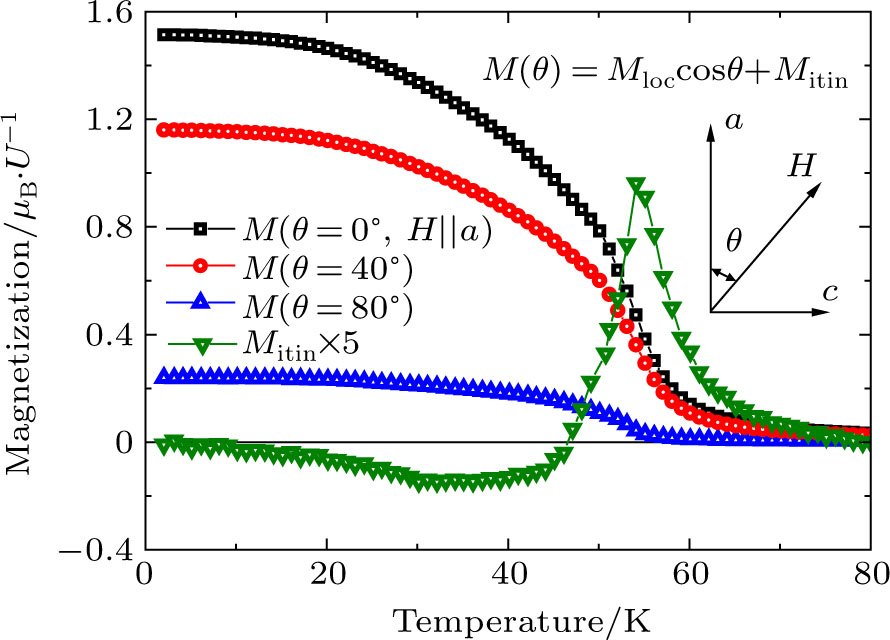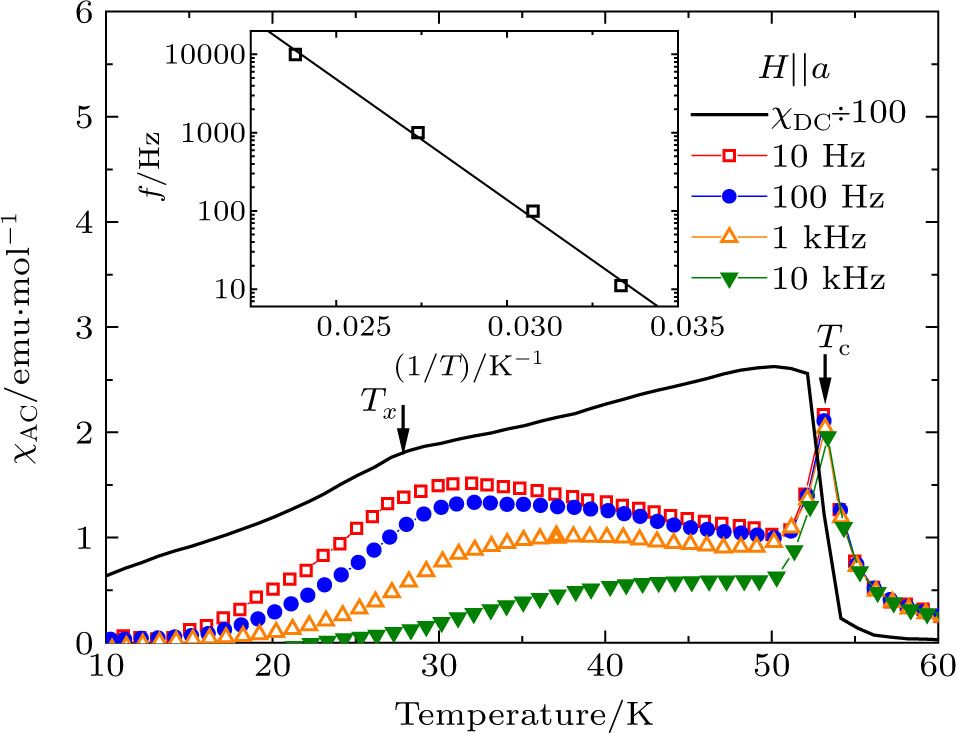† Corresponding author. E-mail:
The heavy fermion physics arises from the complex interplay of nearly localized 4f/5f electrons and itinerant band-like ones, yielding heavy quasiparticles with an effective mass about 100 times (or more) of the bare electrons. Recently, experimental and theoretical investigations point out a localized and delocalized dual nature in actinide compounds, where itinerant quasiparticles account for the unconventional superconductivity in the vicinity of a magnetic instability. Here we report the strong coupling between localized 5f moments and itinerant quasiparticles in the ferromagnetic superconductor UGe2. The coupling is nearly antiferromagnetic. As embedded in the ferromagnetic matrix of localized 5f moments below 

In heavy fermion materials, Kondo lattice is a prototypical model to describe interacting localized 4f/5f moments coupled antiferromagnetically to the conduction electron sea.[1] As a consequence of the collective hybridization, the system can approximately be described by two renormalized components, i.e., itinerant heavy quasiparticles (so-called the Kondo liquid) and unhybridized localized moments.[2] At low temperatures, itinerant quasiparticles due to the hybridization are believed to lead to a rich variety of emergent quantum phenomena such as unconventional superconductivity.
The ferromagnetic superconductor UGe2 is an exotic example displaying both local-moment and heavy-mass itinerant behavior due to the peculiar dual character of 5f electrons.[3–9] This compound is unique, since pronounced localized 5f electrons are mainly responsible for bulk properties such as the giant magnetocrystalline anisotropy with the easy axis aligning along the a direction and the relatively large ferromagnetic moment, 




Recently, the change at TX is demonstrated to be a crossover at ambient pressure, instead of a sharp thermodynamic phase transition, and no discontinuity has been detected in heat-capacity, thermal-expansion, neutron scattering, nuclear magnetic resonance, and nuclear quadrupole resonance measurements.[14–17] Moreover, TX at 1.2 GPa is established to be a first-order phase transition, which is apparently in contrast with the theoretical prediction that quantum phase transitions should be of second order.[18] Driven by quantum fluctuations, such a first-order phase transition is usually pre-empted by the formation of an inhomogeneous magnetic phase.[19] In this paper, we show the strong coupling between localized 5f moments and itinerant quasiparticles in UGe2 by conventional magnetic measurements. Our results clearly indicate the emergence of short-range dynamic correlations of itinerant quasiparticles embedded in the FM matrix of localized 5f moments. Further, these itinerant quasiparticles form a cluster-glass state below TX, shedding new light on the coexistence between ferromagnetism and superconductivity.
High-quality single crystals of UGe2 were grown by Czochralski pulling method in a tetra-arc furnace under protective argon atmosphere. A small oriented cubic lump was cut from the cleaved ingot, and subsequently annealed at 1073 K under ultrahigh vacuum for a week. The quality of the specimen was verified by means of x-ray diffractions. The residual resistivity ratio ρ (300 K)/ρ (2 K) amounts to 435, confirming the high quality of the single crystals. Magnetic measurements were performed using a quantum design magnetic property measurement system (MPMS), in the temperature range from 2 K to 300 K and in magnetic fields up to 50 kOe. In the measurements of field-cooling (FC) magnetization, data were recorded on cooling in a magnetic field of 5 kOe. In the measurements of thermal remanent magnetization (TRM), data were recorded on warming in zero field, after an FC process in 5 kOe. In the measurements of ac susceptibility, a dc bias field of 1 kOe was always applied, and an ac excitation of 10 Oe was used, operating at 10 Hz, 100 Hz, 1 kHz, and 10 kHz, respectively. Both dc and ac magnetic fields in measurements were applied along the a direction, the easy axis of magnetization.
Figure 




In TRM measurements, it is necessary to check the real applied magnetic field in the magnetometer, since a residual field of typically ±5 Oe usually remains in the superconducting magnet of MPMS. Hence, we repeat TRM measurements in ±10 Oe to eliminate the confusion from the residual field, as shown in Fig.
We now emphasize the importance of TRM measurements. In the dualism of 5f electrons, UGe2 has to be viewed schematically as a two-subset electronic system, where localized 5f electrons coexist with itinerant quasiparticles. Since the contribution of itinerant quasiparticles is weak in bulk properties, it is commonly difficult to exactly tell apart their behavior by magnetic measurements. However, in a different way, TRM tries to approach the zero-field limit of the FM monodomain of localized 5f electrons, and then the AFM coupling in some senses induces a detectable component from itinerant quasiparticles. Both components of localized and itinerant 5f electrons were apparently identified, namely 

To further demonstrate the novel features of itinerant quasiparticles, we have measured the temperature dependences of FC magnetization in rotating magnetic fields within the ac plane, as shown in Fig. 






The spin-glass behavior of itinerant quasiparticles is clearly reflected in the frequency-dependent magnetic ac susceptibility of UGe2, as shown in Fig. 



The short-range order of itinerant quasiparticles can be understood in the framework of quantum phase transitions (QPTs) in metallic ferromagnets. When the control parameter is tuned towards a putative quantum critical point (QCP), QPTs may be discontinuous or continuous, and even a state with glass-like spin dynamics is possible.[24] For example, in a clean system CeFePO, the ground state is a short-range ordered state, although it is very close to an FM instability.[25] In view of recent advances on QPTs, we conclude that there are two different FM QCPs in UGe2. As the pressure increases, the disappearance of TC at 1.5 GPa corresponds to the FM QCP of localized 5f electrons, whereas TX is likely to vanish at 1.2 GPa, a putative FM QCP associated with the glass-like short-range order from itinerant quasiparticles. Additionally, TX (∼3 K) is still observable at 1.33 GPa in muon spin relaxation measurements,[21] providing evidence for the tail of the quantum criticality with spin-glass freezings.
We have studied the strong coupling between localized 5f moments and itinerant quasiparticles by conventional magnetic measurements in the ferromagnetic superconductor UGe2. In both the thermal remanent magnetization and the field-cooling magnetization in rotating magnetic fields, this antiferromagnetic coupling leads to the emergence of short-range dynamic correlations, characterized by magnetic fluctuations of cluster-like spins. Since itinerant quasiparticles are immersed in the ferromagnetic matrix of localized 5f moments below TC, they show a detectable small negative magnetic moment, about 






| [1] | |
| [2] | |
| [3] | |
| [4] | |
| [5] | |
| [6] | |
| [7] | |
| [8] | |
| [9] | |
| [10] | |
| [11] | |
| [12] | |
| [13] | |
| [14] | |
| [15] | |
| [16] | |
| [17] | |
| [18] | |
| [19] | |
| [20] | |
| [21] | |
| [22] | |
| [23] | |
| [24] | |
| [25] | |
| [26] |







